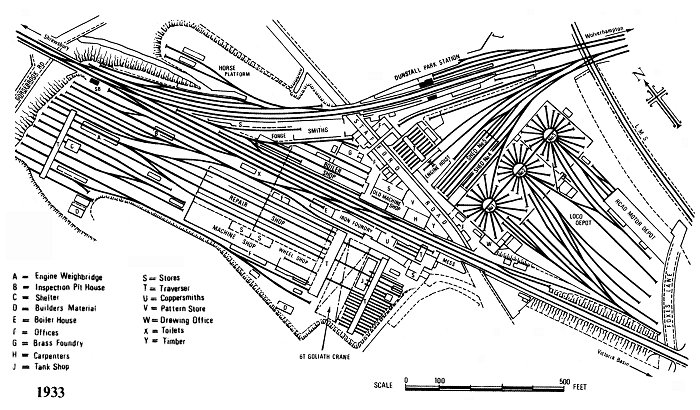
A plan of the GWR shed and Works
area at Wolverhampton Stafford Road circa 1933,
following the expansion of the Works as carried out with
the benefit of a Government grant. The newly developed
site is that to the west side of the Victoria Basin
line, stretching north to a point beyond Stafford Road
Junction, with Oxley viaduct (on the Shrewsbury line)
immediately beyond. |
|
A detailed floor plan of the new repair, erecting, and
machine shop areas, also indicating the uses and
applications for the various equipment. The south end of
the building is to the right of the diagram, the machine
shop being located on the west side of the new
buildings. Author's Collection - Supplement to the
Railway Gazette, 1933. |
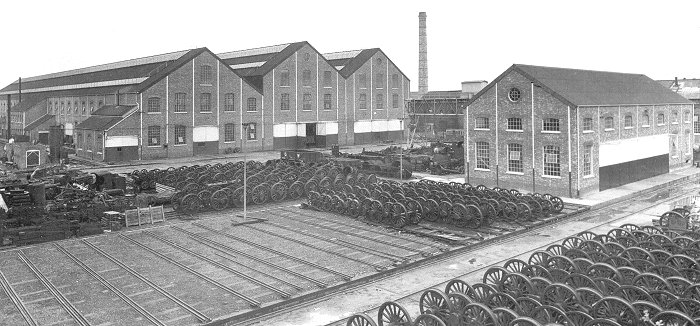
A general view of the newly
completed Works extension, as seen from the south end in
July 1932. The large collection of wheel sets in the
foreground belongs to the various locomotives undergoing
overhaul and repair inside the Works. Beyond the nearest
sets of wheels is the path of a traverser, the building
to the right being the tank shop. Beyond there is the
domain of the six-ton Goliath crane, which is partly in
sight behind the building, and then there is another
traverser across the south end of the main building. The
wheel shop and machine shop are on the nearest side,
with the middle and far bays being the repair or
erecting shop. The need to lift entire engines within
the repair shop necessitated the increased height of the
building for these two bays. Phillip Coutanche
Collection. |
|
As already mentioned, the
newly-regenerated Works was now capable of handling
Heavy repairs to all but the largest locomotives, and
yet even as early as 1939 a scheme had been mooted to
close down the Stafford Road Works. In the event, the
planned closure was summarily postponed with the
outbreak of World War II, and it was not revived.
As with all other manufacturing industries, extra work
had to be undertaken at Stafford Road Works following
the outbreak of World War II in 1939. Swindon Works
became involved in the construction of additional LMS-type
locomotives, and as a result Wolverhampton Works then
had to take on what would otherwise have been 'Swindon
jobs'. Some of the existing LMS and newly-built Ministry
of Supply '8F' 2-8-0s were maintained at Stafford Road
Works. There was also an influx of some of the U.S. Army
Transportation Corps 2-8-0s on loan from the U.S.A.
(built for service in Western Europe) which were brought
up to Wolverhampton for various adjustments to be made
prior to these engines entering service. Despite all of
the air-raids that took place across the industrial
Midlands, the Stafford Road Works did not sustain any
bomb damage, or none that was publicised, and it was
able to carry on with its contribution to the war effort
right through until the time that hostilities ceased in
1945. |
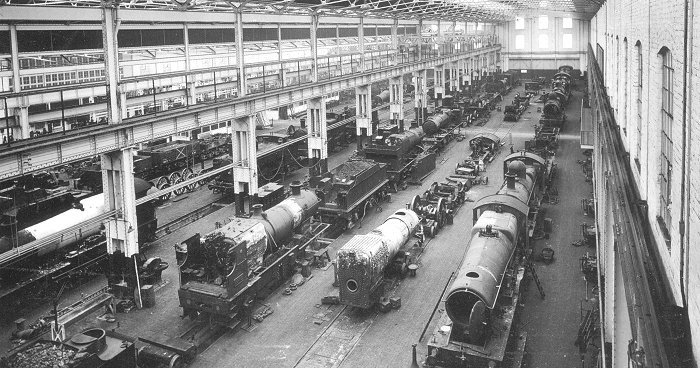
Another official GWR photograph,
taken on 24 April 1932, shows the Works erecting shop.
Locomotives entered the building at the south end, and
repairs were then carried out in various stages along
the 450ft length of the shop. When the wheels had been
replaced, the locomotives were drawn along by an
electric winch set up at the north end for the final
stages of overhaul and repair to be concluded. Heavy
engine parts were moved around by way of four 50-ton
capacity overhead cranes and two 6-ton cranes. Smaller
cranes were also available for use in the adjoining
machine shop. |
|
After the war, the Stafford Road
Works received much of Swindon's second-hand machinery
and had to continue on through the austerity years as
the economy slowly improved, the Works reverting to a
more settled existence again. On a general basis,
nothing much had altered at the Works by the time of
Nationalisation in 1948, and Stafford Road Works was now
incorporated as a part of the now-new British Railways
(Western Region). Locomotive types that were repaired at
the Works during the BR era included almost all of the
Churchward, Collett, and Hawksworth GWR classes, with
some inside visits by the 'Kings'. Among the BR-built
Standard engines, examples of '4MT' and '5MT' 4-6-0s
were also dealt with at Stafford Road Works, together
with the '3MT' rated '82000' series 2-6-2Ts, the '78000'
series 2-6-0s, and even '9F' 2-10-0s. However, a casual
visitor would still have found the usual collection of
small tank engines in and around the Works and sheds.
Some noteworthy visitors to Stafford Road Works included
at least two of the ex-LMS unrebuilt 'Patriot' class
4-6-0s from Bristol (Barrow Road) shed, following the
transfer of that engine shed to the Western Region in
1958, and three ex-London & North Western Railway Webb
'17 inch' Goods 0-6-0s, which were on their way from the
Shropshire & Montgomeryshire Railway to Swindon for
scrapping in 1950. Former Taff Vale Railway tanks,
amongst some other old GWR absorbed types, were also
repaired at Wolverhampton Works in BR days. During the
course of 1956, four ex-LMS Pacifics were loaned to the
Western Region when the Great Western 'Kings' were
temporarily withdrawn as a class for attention to their
front bogies; these Pacific locomotives were also
stabled and also maintained at Stafford Road during that
period. |
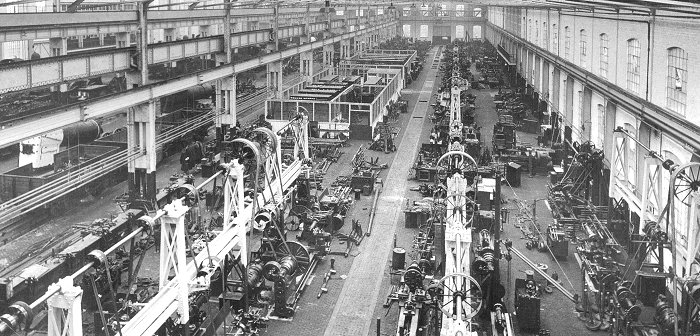
The machine section inside the new
Stafford Road Works erecting shop is seen in an official
GWR publicity photograph issued by the drawing office at
Swindon on 27 July 1932, shortly after the completion of
the Government grant-assisted project. The enlargement
of the Works was carried out with the assistance of
funding made available under the provisions of the Loans
& Guarantee Act, 1929, which was introduced to help
alleviate national unemployment. Building work commenced
on 5 November 1929 on the site to the rear of the old
S&BR shops, and was finalised by 1932. This was one of a
series of large glass-plate photographs taken by the GWR
photographer both during the construction and soon after
completion of the Works extension, most, if not all of
which still exist. The machine tools were arranged in
groups of eight, the electricity to power them being
supplied by the Wolverhampton Corporation at 6,000
volts. |
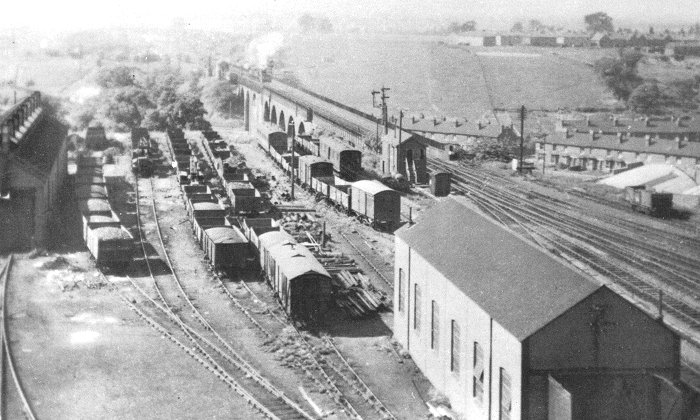
A view from the roof of the 1932
repair shop at Stafford Road, looking towards Oxley
viaduct and Shrewsbury. The pointwork on the right is
Stafford Road Junction, where Up passenger trains
diverged left for Wolverhampton (Low Level), the line
straight on (passing between the expanded Works site)
being for Victoria Basin. Within the Works site itself,
the engine weighbridge house is on the left. It was here
that newly-repaired locomotives were given their first
steaming. Able to cater for all sizes of GWR
locomotives, prior to this, newly repaired locomotives
had to be sent over to Tyseley to be weighed before
being allowed back into traffic. The building in the
foreground is the inspection pit house. Author's
Collection. |
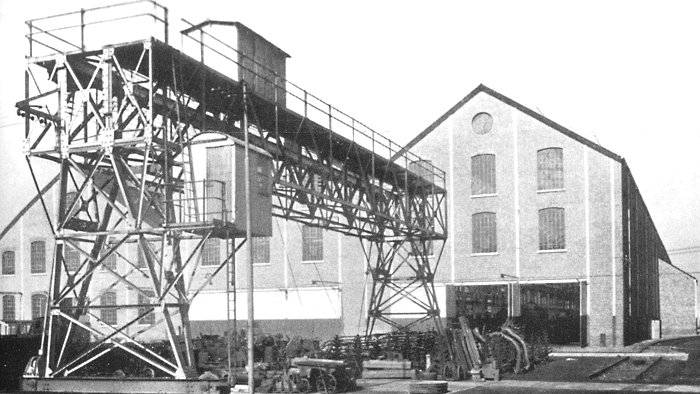
The 6-ton gantry crane that served
the Works inspection yard. This travelling crane spanned
nine roads of track and was installed during the course
of the 1931/32 enlargement of the Works. Author’s
Collection - Supplement to the Railway Gazette, 1933. |
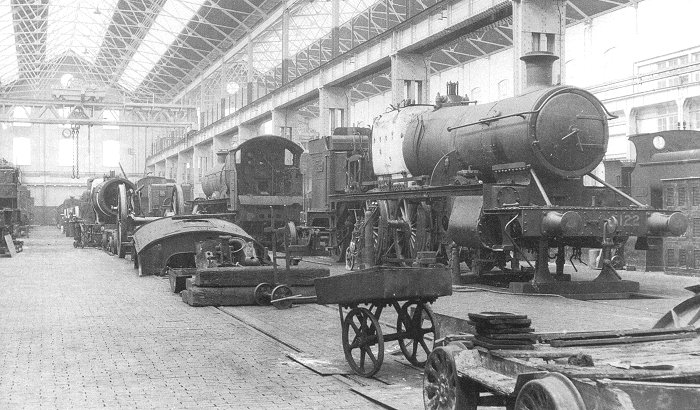
The photograph above and the one
below were taken on the same day in 1935. They combine
to show the length of the erecting shop at Stafford Road
Works, as both ends of the building are collectively
shown. The smokebox and bunker ends of 2-6-2T No 5122
(built at Swindon Works in 1905) help to locate the
photographer's relative position between the two scenes.
The 2-6-2T's side tanks have been removed and are out of
view; they are probably receiving attention elsewhere in
the Works as other removed parts seem to be in the
centre of the erecting shop. Various 0-6-0PTs and
passenger class locomotives are also receiving
attention. The view is probably photographed at a
weekend or during a lunch break, hence the absence of
staff, the two 50-ton overhead cranes that serve this
side of the erecting shop being parked at the
extremities of the building. Both Lens of Sutton
Collection. |
|
As is well known, it was during the
1950s that British Railways began to further its major
modernisation plan, which included the rapid replacement
of steam locomotives with diesel and electric power.
Even so, Stafford Road Works was still expected to
continue to have a future in the new order of things, an
internal report stating that 'The modernisation
programme, in its furtherance of the progress of the
railways, will make itself felt in Stafford Road Works
as the steam locomotive is replaced by the new
diesel-hydraulic and diesel-electric locomotives. These
changes will, in time, bring a different class of work
and repair to Stafford Road, and to meet this change,
proposals and plans are being formulated for these Works
to undertake the maintenance of main-line diesel
locomotives in the future'. |
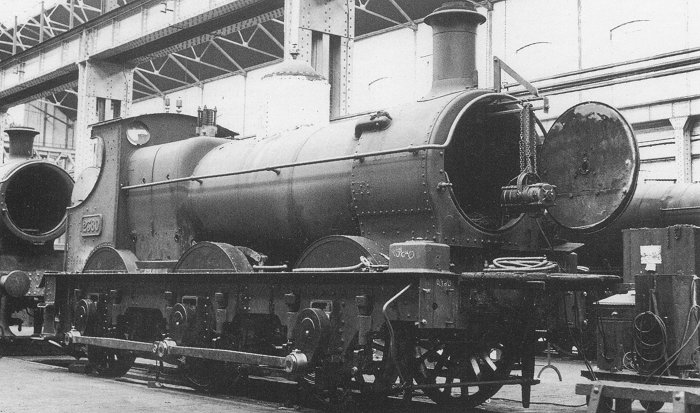
An 0-6-0 locomotive, No 2380,
the last of the '2361' class to be built, is seen
nearing the end of a General overhaul on 3 March
1937 at a time when the engine has just six years of
service left before its withdrawal. A compressed-air
device hangs outside of the smokebox, this being
used to expand the ends of the boiler tubes.
Author's Collection. |
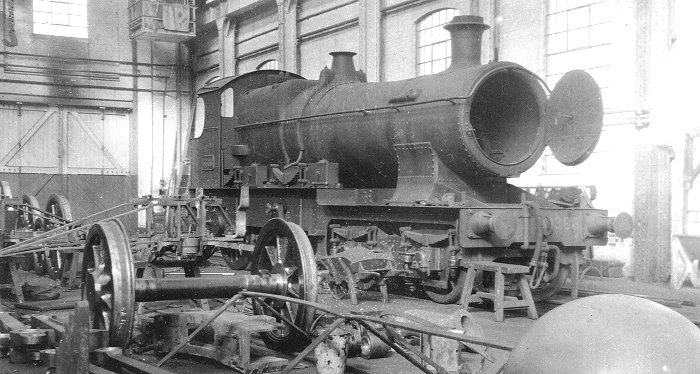
A GWR 4-4-0 locomotive, No
3366 (formerly Earl of Cork) is pictured
awaiting attention in Stafford Road Works on 1
March 1939. R. M. Casserley Collection. |
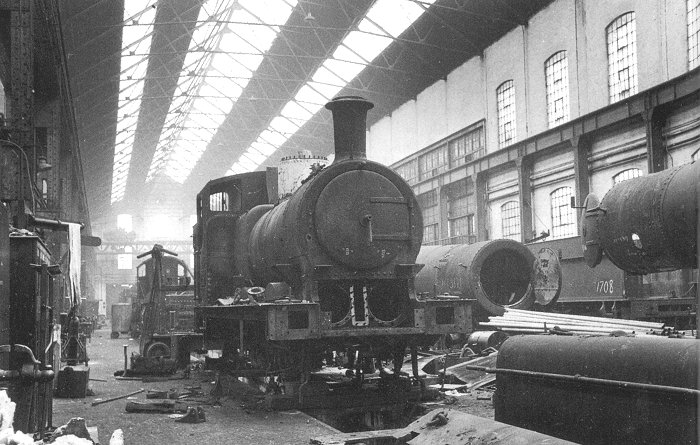
A busy scene in the
early years of British Railways (Western
Region) activity at the Stafford Road Works
shows 0-6-0PT No 3740, without its pannier
tanks, undergoing an extensive overhaul on 7
May 1950. Author's Collection/R. S.
Carpenter Photos. |
|
Swindon Works was, however, by now very
much involved in the manufacture of the
new diesel-hydraulic locomotives. As a
result, the Stafford Road Works was
called upon to deal with a great deal of
the steam locomotive maintenance work
which would otherwise have been carried
out at Swindon, and during the course of
1959 some 310 locomotives and 183
boilers were all repaired at
Wolverhampton Works. It was in that year
that a list of closures for various
Locomotive Works appeared in The Sunday
Times and also in The New Statesman,
with Stafford Road being on the closures
list.
It seems that the management at Stafford
Road Works were themselves unaware of
the intended closure, and so urgent
enquiries brought an assurance that the
Wolverhampton jobs were safe, for the
Works had been designated to become a
main-line diesel maintenance depot.
However, apart from a brief guest
appearance on the canal-side coaling
stage turntable of Stafford Road running
shed by the prototype Birmingham Railway
Carriage & Wagon Company diesel
locomotive Lion in May of 1962, nothing
was to come of this proposal. Even when
the new 'Western' class diesel-hydraulic
locomotives started to make their
appearance later on in the same month
(prior to the wholesale withdrawal of
the 'Kings' in September 1963), these
were all stabled over at Oxley shed, and
likewise with the Brush Sulzer Type '4'
diesels which followed, instead of
sending them to Stafford Road. The end
was very clearly now in sight, and it
was to come within the next two years. |
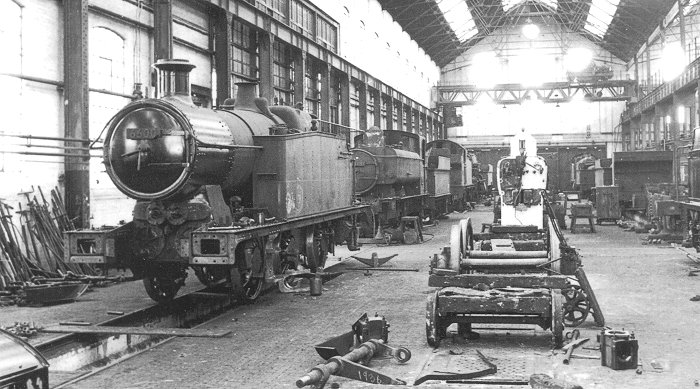
0-6-2T No 6600
is seen mid-overhaul inside the 1932
Stafford Road Works building, circa
1960, together with an 0-6-0T that
is believed to be No 9618 and a
2-6-2 Prairie tank, which are
awaiting attention to the rear of
the line. By this time Swindon Works
was already at the heart of the
Western Region's move to
diesel-hydraulic traction, and so
Wolverhampton had been benefiting
from additional steam work. However,
a closure threat suddenly looming
during a very busy 1959 saw staff at
all levels concerned about the
future. They were reassured that
Wolverhampton Works would ultimately
be a main line diesel repair depot,
so their jobs were safe. Author's
Collection. |
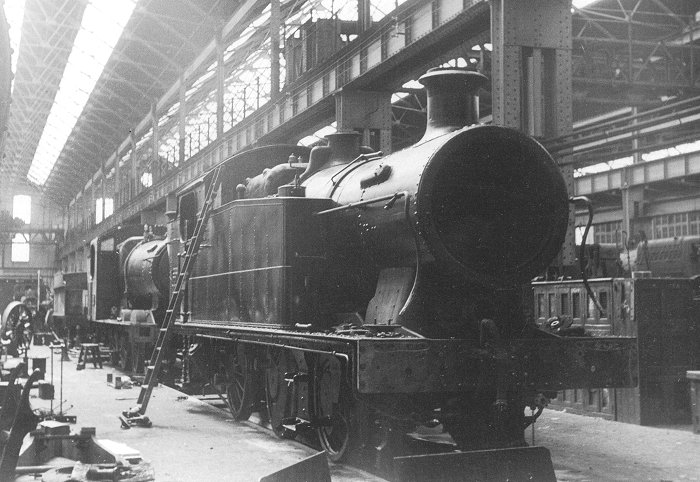
A '5600'
class 0 6 2T and '8400' 0-6-0T
are seen approaching the end of
repairs in the eastern bay of
the 1932 repair shop in 1962, in
a view looking south. Simon
Dewey. |
|
The
Wolverhampton Express & Star
newspaper reported in the
September of 1963 that the
first forty-one Stafford
Road employees had been
given six-weeks notice of
redundancy. This was done by
way of a single-page
pro-forma letter, with the
employee's name written in
by hand. Following departure
of the last locomotive in
February 1964, Stafford Road
Works was then closed
completely in June of that
year, after 115 years of
history, with over five
hundred men in total losing
their jobs. Many of the
redundant employees went on
to find alternative jobs
with places like the
Goodyear Tyre Factory,
Courtaulds, and the local
aerospace factories,
usually, it has to be said,
at better rates of pay. |
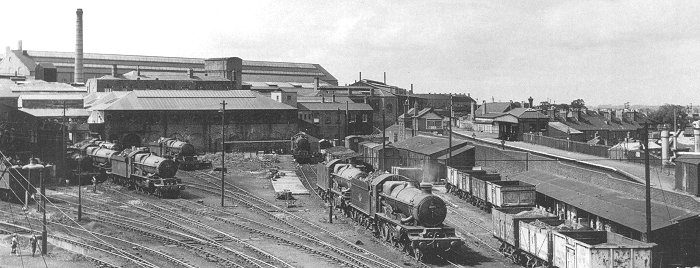
Stafford Road lower
yard, around September
1962, with the sprawling
Works complex in the
background and Dunstall
Park station to the
right. This part of the
Works site was developed
in the 1850s, and this
photograph makes an
interesting comparison
with that taken from a
near identical position
in 1883, as seen in part
one. The most prominent
locomotive in this scene
is No 4096 Highclere
Castle, with its
distinctive
curved-pattern
inside-cylinder casing.
This 4-6-0 locomotive
would be in charge of
the last 'Cornishman'
working out from
Wolverhampton (Low
Level) station on
Sunday, 9 September
1963. J. B. Bucknall. |
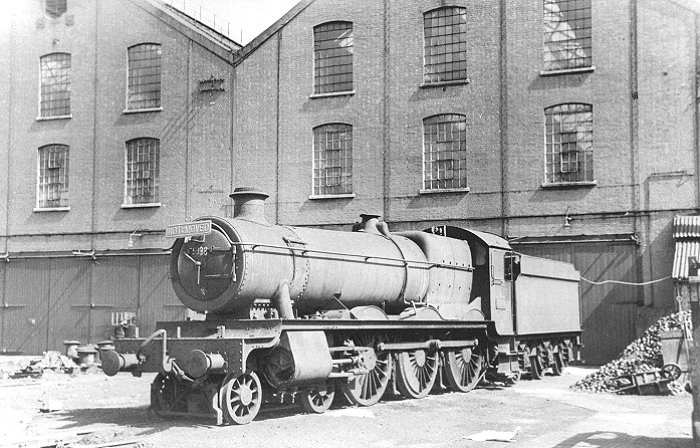
No 5938 5tanley Hall
is seen here in use
as a stationary
boiler outside of
the main Works
erecting shop in
June 1963, having
been condemned the
previous month. This
4-6-0 locomotive
would subsequently
be cut up at
Stafford Road Works
by September 1963.
Simon Dewey. |
 |
|
 |
|
 |
Return to
part 2 |
|
Return to
the beginning |
|
Proceed to
part 4 |
|